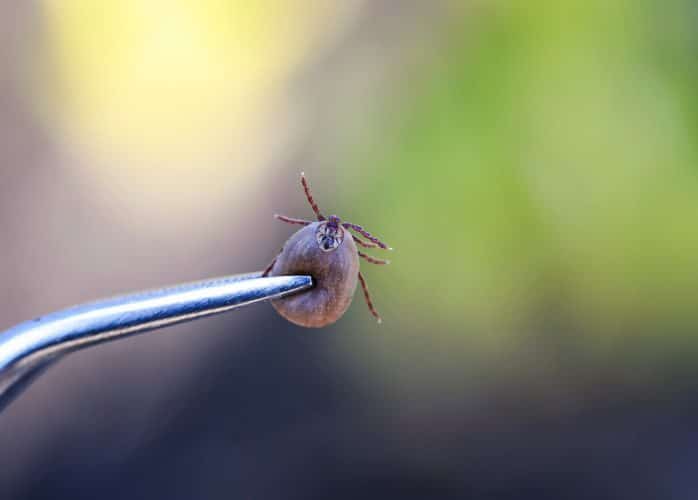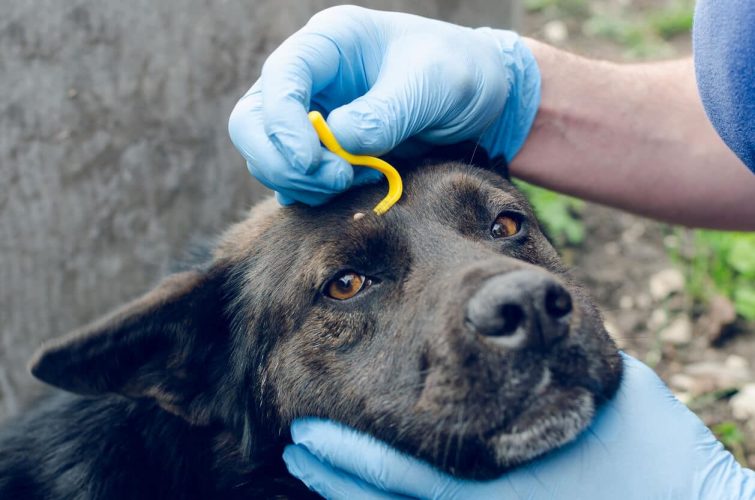It’s important to remove any ticks from your dog right away—as soon as you notice them, in fact!
Tick bites can transmit bacteria that cause serious infections like Lyme disease. But even Lyme-free ticks can irritate your dog’s skin, and a group of ticks may drink enough of your pet’s blood to cause anaemia.
When you do notice a tick, scratching it off with your bare fingers may seem like a fast and easy approach to removal, but this strategy is risky. Any contact with the tick’s body fluids can transfer bacteria to your fingers. That means the next time you touch your mouth or eyes, you might deliver tick-borne diseases directly into your system.
But rest assured: it’s possible to remove ticks at home safely without hurting your pet or putting yourself at risk of disease. Read on to get the details, including some expert guidance on spotting and removing ticks.
What You’ll Need Before Getting Started
Before trying to remove a tick, you may find it helpful to gather all the supplies you need for sanitary tick removal.
The following items may come in handy:
- Latex gloves. These protect your skin from tick blood and saliva.
- Tweezers. Choose ones with tips that bend inward. Flat-tipped tweezers are more likely to squish the tick than lift it.
- Extra lighting. A lamp or torch can help you see what you’re doing, especially if your dog has long, thick fur.
- Magnifying glass. You may find it difficult to see some ticks with your naked eye.
- Container with a tight lid. Trapping the tick can keep it from escaping and biting your dog again.
- Isopropyl alcohol. Ticks can survive underwater for weeks, so if you want to drown one, you need alcohol.
- Mild antiseptic solution. Antiseptic helps sanitise the bite area after you get rid of the tick.
- Treats. Most dogs won’t love the tick removal session. Offering their favourite snack or chew can help distract them as you poke around their fur with tweezers.
How to Get Rid of Ticks with Tweezers: A Step-by-Step Guide
“Tweezers and specialised tick removal tools are generally considered the preferred options for removing ticks from dogs,” says Alejandro Caos, DVM, veterinarian at The Vets. Classic tick removal tools often look like tongs with the tips bent at an angle.
According to Dr Caos, you’ll follow the same basic steps when using tweezers or a tick removal tool:
- Grasp the tick as close to your dog’s skin as possible.
- Pull the tick gently and steadily up. Try not to twist or crush the tick’s abdomen, as you may leave the disembodied head still latched onto the skin.
- Dispose of the tick by placing it in a container with rubbing alcohol or flushing it down the toilet.
- Disinfect the bite area with some mild antiseptic solution or water and gentle soap.
- Monitor the bite area over the next few days for signs of infection. Take note if the bite gets redder and more inflamed over time or fills up with foul-smelling pus. If you notice pus or inflammation, call your vet.
What To Avoid When Removing Ticks From Dogs
Plenty of tick-removal devices besides tweezers exist—but your dog’s fur can make these other methods a bit unwieldy.
For instance, if you need to hold a tick card flush against the skin, your dog’s fur—especially if it’s long or thick—can make this difficult.
“Tick cards, tick pens, and tick loops are typically designed for use on humans,” says Dr Caos. “While they may work on dogs in some cases, they’re not the most effective or recommended method for tick removal on dogs.”
That said, these tweezer alternatives don’t pose a health risk, though they aren’t ideal. Other tick removal ‘tricks’ you come across online, however, may be downright dangerous.
Experts don’t recommend trying to draw the tick out with nail polish, oils, alcohol, or petroleum jelly. Smothering a tick can cause them to throw up saliva, which only speeds up the invasion of bacteria into your dog’s body. Plus, some of these substances may damage your dog’s skin.
Important: Never try to burn a tick off your dog. Not only will this cause the tick to throw up, but you could also burn your dog’s fur or skin in the process.
How To Spot Ticks On Your Dog
“Searching a dog for ticks is an important part of regular pet care, especially if you live in an area where ticks are prevalent,” Dr Caos says.
Ticks can be hard to notice when they first feed. However, an infected tick bite can get pretty itchy, so your dog may scratch, lick, or chew on the affected area.
How to check for ticks
“Start by running your hands over your dog’s entire body, feeling for any small bumps or irregularities,” Dr Caos advises. Then, use a fine-toothed comb to part your dog’s fur and inspect the skin visually. Look carefully, since ticks excel at hiding.
What ticks look like on the body
“Ticks can vary in colour, but they often appear as small, dark, or reddish-brown specks on the skin,” Dr Caos says.
Ticks grow visibly larger and rounder as they feed on blood over several days. For example, an unfed American dog tick is 3-5 mm long, but an engorged tick can grow up to 15 mm long (about the width of the pad of your finger.
Where to check for ticks
Ticks can feed anywhere on your dog, but they prefer to settle down for lunch in dark places hidden from view. Dr Caos says ticks are commonly found around a dog’s ears, ear flaps, and the creases between their toes. They may also show up on your dog’s neck, belly, tail, and ‘underarms’ (where their legs meet their torso).
When to look for ticks
“Remember to perform regular tick checks, particularly after your dog has been in areas known to harbour ticks, like tall grass, wooded areas, or hiking trails,” Dr Caos says.
This is important in colder months as well as warmer ones. It may not be strictly ‘tick season’, but these parasites will wake up for a mid-winter snack if they smell a convenient meal nearby.
Preventing Tick-Borne Diseases
In general, a tick needs to feed on your dog for a day or two before enough bacteria from their spit transfers over to cause disease. Tick prevention products repel or kill them before they can infect your dog.
Tick prevention methods include:
- Oral medication. Your dog can swallow a pill or chew a tablet that puts a drug in their bloodstream. The drug kills the tick if it drinks too much blood.
- Tick collar. These collars repel ticks.
- Topical treatments. You can also apply creams or sprays that repel and kill ticks on your dog’s skin.
Your vet can help you choose the most appropriate product for your dog.
Tick Troubleshooting: FAQs
Got more questions? We’ve got answers!
What happens if I can’t remove the tick?
“If you are unable to remove the tick yourself, or if the tick’s head is lodged in the skin, it’s best to seek professional help from a veterinarian. They have the necessary tools and expertise to safely remove the tick without causing harm to your dog,” Dr Caos says.
How do I know if my dog has a tick-borne disease?
Signs of tick-borne disease may not show up until one to three weeks after the initial bite.
Dr Caos says to pay attention to the following signs:
When should I take my dog to the vet?
While tick bites can often be handled at home, you may need to call a vet if:
- You can’t remove the tick. Maybe you have clumsy fingers, or your dog just won’t sit still. It’s always fine to ask for extra help removing ticks!
- You find a heavy infestation. A bunch of ticks all feeding at once can drain a dangerous amount of blood from your dog. Even if you find and remove each tick, you’ll likely want a vet to check your dog for health issues.
- The bite gets infected. While you may see a pink bump immediately after removing the tick, an infected bite will grow redder and bigger over time.
- You see signs of tick-borne disease. If your dog loses interest in eating or playing or develops a noticeable fever, contact your vet right away.
Keep in mind, too, that every dog is different! Your vet can offer more guidance on the best treatment for your pet’s unique situation.





